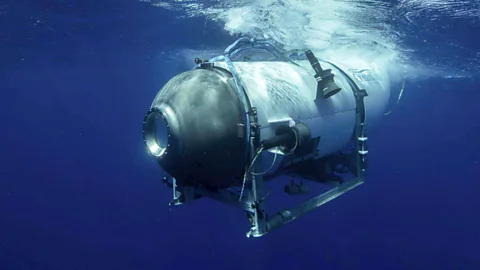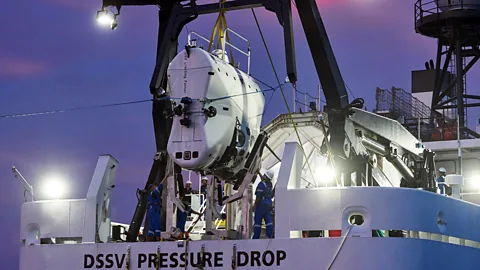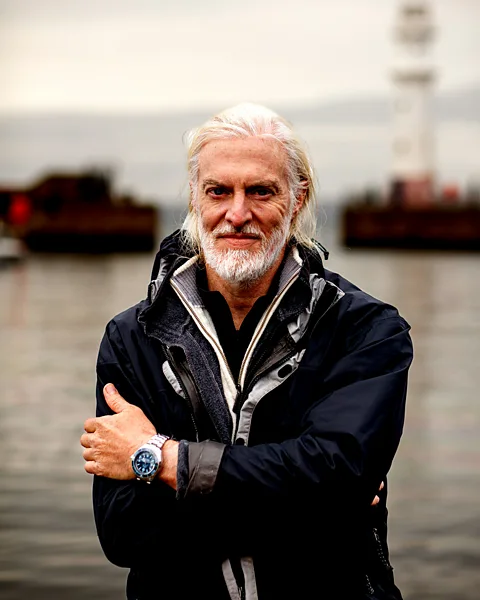What the Titan failure has taught us about exploring the deep ocean
 Getty Images
Getty ImagesOne year ago, the Titan submersible was destroyed on an ill-fated mission to the wreck of the Titanic. Ocean explorer Victor Vescovo explains why the mishap could make future deep-ocean voyages safer.
"[The Ocean] is a place where you've got to really know your stuff before you can step outside the box. You don't move fast and break things, as they say in Silicon Valley, if the thing you're going to break has got you inside it."
– Deep-ocean explorer, scientist and film-maker James Cameron, appearing on 60 Minutes Australia, 9 June 2024
It has been a year since the submersible Titan imploded at the site of the RMS Titanic. Two of my friends and colleagues, PH Nargeolet from France and Hamish Harding from the UK, were onboard. I worked extensively with P H for several years on the design and operation of the ultra-deep diving submersible Limiting Factor, while Hamish and I visited the deepest point in the ocean, Challenger Deep, together. Their loss was not just a big news story: to me, it was personal.
A year later, many ask: "How has the incident changed deep-water exploration?"
There are two answers.
The first is: "I very much hope, not much."
By that I mean that I sincerely hope that this incident does not make people more fearful of diving into the depths of the extraordinary ocean, the lifeblood of our world. Three-quarters of the world's ocean is completely unexplored, home to multitudes of undiscovered species, to geologic puzzles that can help us understand seaquakes and tsunamis, and possibly insights into how the world is affected by climate change.
Unfortunately, the sensationalism surrounding the accident and the instinctive fear many people have of the deep ocean have perhaps made some of those unfamiliar with submersibles more anxious about getting into one. But this absolutely should not be the case; just as people should not stop travelling by air after they hear reports of a fatal aircraft accident. Those of us in the submersible community – the builders, pilots, and researchers – have not hesitated in continuing to extensively dive in these vehicles, which should give everyone else confidence in their safety.
 Reeve Jolliffe/Caladan Oceanic
Reeve Jolliffe/Caladan OceanicIt is very important to understand the complete unconventionality of the Titan submersible. It was an aberration in the history of submersible design, operation, and safety. The Titan was principally constructed of carbon fibre, molded into the shape of a cylinder, where every other deep-diving submersible is based on a metal or acrylic sphere. Safety concerns about the vessel were raised as far back as 2018, according to former employees of OceanGate, the company that owned the Titan. Virtually every deep ocean engineering expert I know also implored OceanGate not to dive the Titan and communicated that it was only a matter of time before the submersible imploded and people would be killed.
Those warnings were ignored.
Please let me repeat: It is crucial for people to understand that there are very well-established, safe ways to build and operate deep-ocean submersibles. For 50 years, there has not been a human fatality or even serious human injury when diving in civilian submersibles based on these principles. Properly certified submersibles (or "classed" as is said in the industry) are like FAA-approved aircraft, as pioneered by the industry leader and builder of my own advanced submersible, Triton Submarines of Florida, which only builds properly certified submersibles.
Huge numbers of dives have been made to depths far surpassing that of the Titan, all without incident. I myself have piloted a submersible beyond 10,000m (33,000ft) – two-and-a-half-times deeper than Titanic – 19 times. It can be done safely and repeatedly and while taking other people along for the amazing journey.
Unfortunately, the founder and chief sub pilot of OceanGate, Stockton Rush, dismissed safety concerns as standing in the way of innovation and his ambition of establishing a viable commercial operation. He used carbon fibre so that he could construct a vessel big enough to carry sufficient passengers to pay for the high costs of building and operating a deep-diving submersible. Those compromises for the sake of economics, and potential technological bragging rights against what he perceived as an overly conservative industry, proved fatal.
Historical similarities abound. The Titanic did not adequately heed warnings of extensive icebergs on its route, just as Oceangate ignored warnings of its flawed design. Titanic had insufficient lifeboats because more would have allegedly cluttered the deck and ruined the view for passengers, while the Titan used carbon fibre so more people could be fitted into it. And there was of course, the never-ending tale of hubris: Titanic was "too big to sink" and the Titan was to be a "revolutionary". Both were deemed perfectly safe by their owners and yet they both were not. At all.
There is a second way the loss of the Titan could affect deep ocean exploration. The accident, in an almost eerie way, repeated many of the elements that contributed to the tragedy of the Titanic over a hundred years before it. However, the disaster could – and should – have a similar positive effect on future worldwide safety regulations.
 Robert Ormerod
Robert OrmerodIn the wake of the loss of the Titanic, strict Safety of Life at Sea (Solas) regulations were created and endure to this day. These stringent regulations govern the equipment, procedures, and training that are required to operate commercial vessels at sea. Therefore, the loss of Titanic, as tragic as it was, saved significantly more lives in the aftermath by spurring new safety measures to prevent a similar tragedy from ever happening again.
So, too, is the glimmer of hope from the Titan disaster. While we still await the results of two official investigations into the accident by the US Coast Guard and the Transportation Safety Board of Canada, there are calls to tighten the safety measures in the submersible industry. "Non-classed" submersibles (that is, not certified by accredited third parties) should never be allowed to transport commercial passengers. Just like in aviation, experimental craft can and should be allowed to operate so that we may push the boundaries of technology, safety, and capability, but people who have no idea how to calibrate the risks they are taking should not be able to buy tickets to travel in experimental craft.
Simply signing a waiver, skirting the law by operating in international waters, or using legal judo to classify commercial passengers as "crew" when they clearly are not, shouldn't shield risky operators from prohibitions on operating as well as retroactive legal action when they come back to any port.
More like this:
• Why the waters around the Titanic are still treacherous
Another key point is that – as with so many other aspects of our world – money spent on tourism, yes, even deep ocean tourism to a wreck, provides funding for the development of technology and procedures to make ocean exploration more affordable, repeatable and safer. Insufficient funding is provided to develop marine technology, so supporting ocean tourism is necessary if we want to make it more accessible over time. But it must be safe and follow established safety protocols.
Humankind should never pull back from exploration and exposing as many people as possible to the extraordinary wonders of our world – including down into the deep ocean. We must do so in order to better understand, appreciate, and preserve it as well as nurture that most definitive and extraordinary aspect of human nature: the need to explore.
Recently commenting on the loss of the Titan and our mutual friend, P H Nargeolet, James Cameron gave what I believe are the best, closing words on the tragedy, from that same interview:
"Exploration will proceed because it must, and because it is part of the human spirit… If it's done right, it can be done safely."
--
Victor L Vescovo is a deep ocean explorer, certified submersible test pilot, former Commander in the US Navy, and venture capitalist. He has visited Titanic three times, was the first person to visit the deepest point in all five of the world's oceans, and has visited the deepest point in the ocean, Challenger Deep, 15 times.
--
If you liked this story, sign up for The Essential List newsletter – a handpicked selection of features, videos and can't-miss news, delivered to your inbox twice a week.
